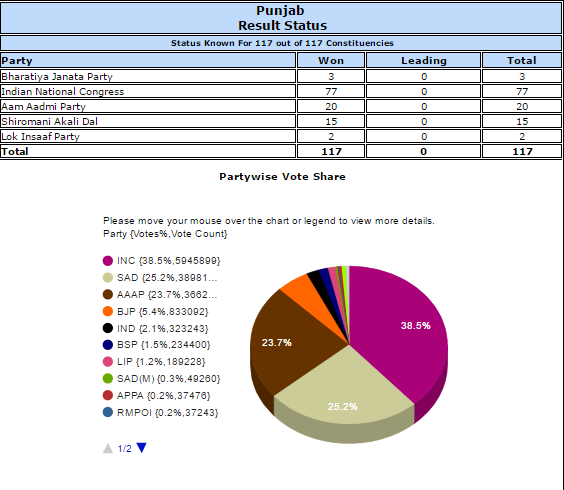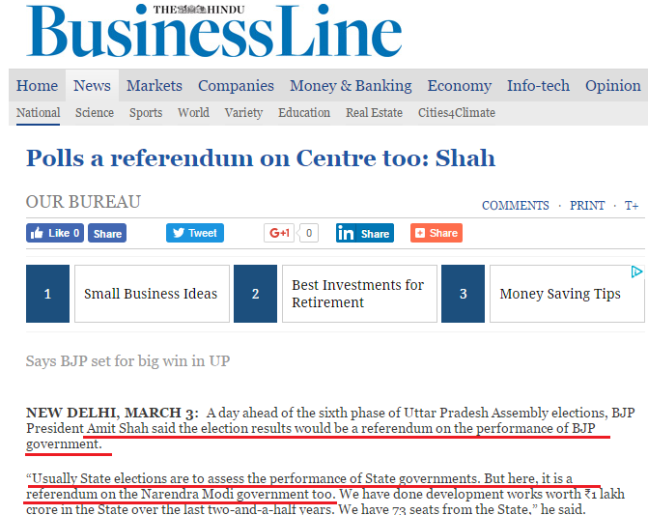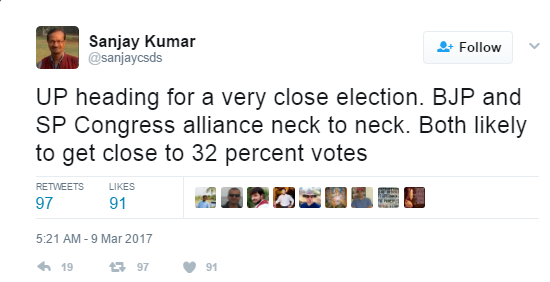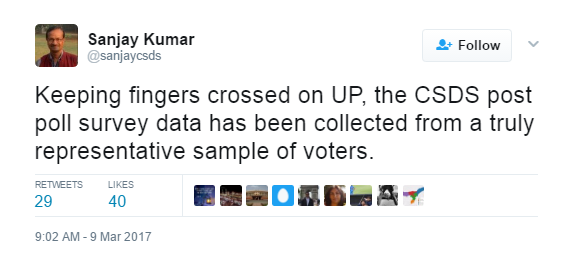Uttar Pradesh and adjoining Uttarakhand saw a BJP or rather Modi Tsunami. Manipur too is looking ripe for picking by the BJP. But in Goa, the BJP deflated from a commanding 21 (20 is the half way mark), to a lowly 13. In Punjab, the BJP was a much smaller player since SAD was the bigger partner, and in that sense, Goa has broken a nationwide trend of a BJP upsurge.
It was a multi-cornered contest in Goa, the “Right” space being fought for by BJP, former partner MGP, and RSS faction led GSM. The “Left” space was being fought for by Congress, NCP and its splinters like GFP, GVP etc. Add to this, the enthusiastic AAP. In an earlier post predicting the Goa elections in January 2017, I had elicited two possibilities: a split in the anti-BJP votes, leading to BJP coming close to the majority mark OR a consolidation of the anti-BJP votes, leading to a fight between BJP and Congress for the single largest party. The second scenario has played out, and Congress with 17 has its nose ahead.
Where BJP lost its way
For the first time, a sitting Chief Minister lost his seat in Goa, that too by a huge margin. Besides him, 4 senior two-term MLAs and Ministers also lost their seats, some by big margins. On the other hand, both Christian Ministers retained their seats, all Christian MLAs (6 including aforesaid 2 ministers) retained their seats, and BJP added one more Christian MLA, thus having more Christian MLAs (7) than Hindu MLAs right now. Also, most of the MLAs who have won from BJP, are “younger” or “newer” faces, with most of the old guard losing. The messages are clear:
1. Voters rejected the arrogance & non-performance of the sitting ministers. Inspite of giving a stable Government which has arguably undertaken maximum development works along with most welfare schemes, these senior ministers failed to win, while their younger counterparts, with no ministries, managed to go through. This shows that the fault lies at the individual level.
2. The Minorities which had backed BJP in 2012 have moved away. This disenchantment was inspite of tremendous appeasement politics of BJP in Goa, which even led to a split in the RSS in Goa. The main reason for this is the polarising image of PM Modi, and Parrikar’s closeness to Modi.
3. A seat by seat analysis shows that in most places where BJP has lost, the split in the saffron forces (BJP-MGP-GSM) hasn’t had much impact. Beyond 3 to 4 seats, this factor hasn’t played out. Thus, it doesnt alone explain the fall from 21 to 13, despite importing 2 sure winners from the Congress.
4. BJP had sensed the imminent defeat of CM Parsekar and had hence probably shied away from declaring him as the CM candidate. The BJP even tried to put Parrikar’s name in the mix, to pull votes. The Defence Minister himself campaigned extensively in many parts of Goa, trying to undo some of the damage. Clearly, the voters have not forgiven the sins of his ministers, just because of his soothing balm.
A Congress Resurgence?
To the plain eye, the rise of the Congress is miraculous. It had won 9 seats in 2012. Out of these BJP poached 2 candidates, and 1 was thrown out by the Congress itself, leaving it with 6 MLAs. Over the last 5 years, the Congress had ceded the space of the “opposition” to smaller regional satraps/independents. Yet, they now managed to reach 17. Is the Congress as a party seeing a revival?
In Goa, the Congress is mostly defined by regional satraps, some of whom cannot see eye to eye even with each other. Thus, to say the “Congress” has won, would be overstating the impact of “Congress” the party. Fact is 4 people who jumped ship from Congress to BJP also won on the BJP ticket, 3 who left Congress for smaller parties also won their respective seats. These people won, without the Congress tag, thus showing that it was their individual strength, which had a large part to play. The 17 seats of the Congress are thus largely due to the presence of strong regional leaders, and the natural swing away from the BJP.
AAP impact?
AAP had projected itself as being in the pole position to usurp the anti-BJP space. Banners of 35% vote-share were plastered all over Goa. They had begun referring to their CM Candidate as the “next CM”. In the end, AAP ended up with 6% vote-share, not a single seat, and the “next CM of Goa”, Elvis Gomes, ended up a lowly fourth in his own constituency. To say that AAP’s performance was underwhelming would be an understatement.
Quite clearly, the anti-BJP vote, especially that of the Christians, did not move much towards AAP, probably because they sensed that AAP would act more as a vote-cutter, than a party which could actually win. This in turn helped Congress get to their tally of 17. The drubbing of the national image of AAP also did no favours to AAP Goa.
The rest: King makers
MGP got 3 seats, same number as it had last time. GFP won 3 seats, up from the lone seat its founder member had won as an independent. NCP won one seat. And the rest went to 1 BJP backed independent, 1 Congress backed independent, and another slightly BJP inclined independent.
Both the BJP (13) or the Congress (17) need the support of all or any of the above to form a Government. This is how the players are inclined:
1. MGP: Was in the Government with Congress till 2012, and then with BJP for 5 years till 2017. It can swing both sides so there is no “ideological” challenge for them. Latest statements indicate that MGP would like to ally with the BJP, but this could quickly change with a sweet deal from Congress.
A twist in the tale: The MGP was for long a party controlled by its 2 MLA brothers: The Dhavlikars. Now, one of them has lost, and for the first time after many years, the MGP has 2 MLAs who are not part of the controlling family. One of these 2 MLAs, is notorious for his party hopping ways, having been in both the BJP and the Congress. He is even rumoured to have said that he s willing to take another MLA and split from the MGP, merging into the BJP. Will that play out? The BJP would love to avoid Dhavlikar, who is know for his ways of extracting a high price for his support.
2. GFP: All MLAs are ex-congressmen. The party was formed on the model of a left-of-centre version of Shiv Sena or MNS, i.e. fiercely protecting Goan identity. The GFP was to ally with the Congress, but ego issues with the Congress state chief meant that some last-minute back-stabbing led them to going their own ways. GFP still remembers this recent double-crossing by the Congress. On the other hand, the GFP mentor has made a mark for himself by his strident anti-BJP and anti-Parrikar position, eating up the opposition space in the state assembly. However, in the past week (probably owing to exit polls), GFP had slightly softened its stand towards BJP. As of now, they indicate that they are open to talks to both BJP and Congress.
The stumbling blocks for GFP would be these: Going with BJP would not suit its ideology. But going with Congress would mean forgiving a deceiver. Worse, Goa Congress Chief and Former CM Luizinho Faleiro is eyeing the CM’s post, and he and the GFP mentor Sardesai are on extremely poor terms. Going with the Congress would mean either GFP takes a back-seat, or Congress goes for another CM face, which would again throw up an internal fight.
3. NCP: NCP as a party is non-existent and is essentially a one man show run by the lone MLA Churchill Alemao, who too can swing both ways if needed. It is more likely he will go with Congress though.
4. The Independents can also be considered to be equally willing to ally with either the BJP or the Congress.
BJP has not given up
Even though the mandate has clearly rejected BJP, BJP is still keeping its options open. Amit Shah mentioned in a press conference that the BJP would form the Government in Goa. At the state level, Parrikar has made it clear that since BJP still enjoys the highest voter-share, BJP has won the popular voter, and will try to provide a “stable” Government, by talking to all MLAs and parties.
With the Centre on its side, a possibly pliable Governor, and an internally divided Congress, the BJP may somehow cobble up 21 MLAs. But such a Government, may not be “morally” acceptable since the verdict is clearly an anti-BJP vote. This experiment, if it happens, could lead to political harakiri for the BJP, unless this hotch-potch Government manages to perform exceedingly well.
The way forward
Ideally, the BJP should let Congress go ahead with forming the Government. The verdict clearly shows the Congress as the winner, and the BJP must be gracious in defeat. The Congress has its own internal squabbles for the CM’s post and has icy relations with potential allies. Such a wobbly Government may not last long and may rekindle the desire among voters to see the stability which BJP had provided them with earlier.
Further, the 2019 Lok Sabha elections are just 2 years away, and the BJP could try to get mid-term polls then, hoping to sail through with the national mood, along with the possible disenchantment of the voters with a shaky Congress led Government. For now, the BJP must accept that in large parts, the BJP itself has defeated the BJP.





























